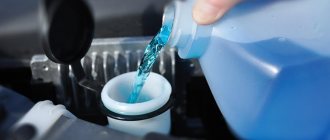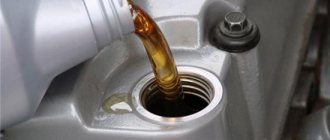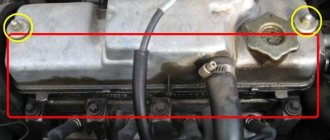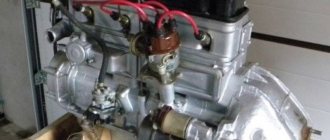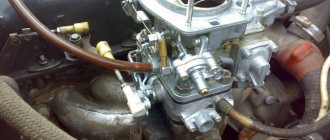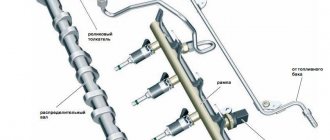The engine in a car should ideally function stably and smoothly. The car's handling characteristics depend on how the engine works. In order for the engine to perform its main functions efficiently, it needs good lubrication. The role of lubricant, of course, is performed by automobile oil. The level must be constantly monitored and in the correct position. This information is not new for every motorist, so a competent car owner knows when and how to add oil to his car.
What does excess or lack of automotive lubricant lead to?
Any experienced driver will tell you that the oil level with a warm engine should be at the mark between the lower and upper bars of the mechanical dipstick.
How to measure the amount of motor oil? Is it possible to add oil to a hot engine? The answer is that it is not advisable, since the level readings will be incorrect, and you can get burned during the procedure. It is recommended to check the level “cold”, after a night of inactivity, or through an express check, which consists of the following. First, you need to warm up the engine power plant to optimal operating condition. A short trip is an excellent way to warm up the engine. After this, the vehicle should be secured on a flat surface, turn off the engine and wait about 20-30 minutes. This is necessary so that the oil mass flows into the oil pan. Next, the lubricant level is measured.
Excess oil
Before adding oil to the engine, it is necessary to take into account the main mistakes that novice drivers make. Most beginners believe that you can pour oil as much as you like or you always need to maintain the level at the maximum level of the oil rod, the effect will only be better.
During operation, the lubricant begins to expand in the vehicle’s engine system. In a high-temperature environment, increased pressure occurs, which has a negative effect on all seals of the operating device. All seals and gaskets begin to squeeze out over time, and engine oil leaks. Crankshaft oil seals are especially sensitive, since the lubricant is supplied under pressure. As a result, the entire interior of the engine becomes dirty, and the seals must be replaced. In addition, there are a number of other consequences of overfilling: it is difficult to start the car in cold weather, “sticking” of piston rings, foaming of the oil composition.
Lack of consumable oil
Lack of lubricant also has a detrimental effect on the vehicle’s power plant. The effect of oil starvation of working units and mechanisms appears, that is, at the moment the engine starts, oil flows to the moving parts in insufficient quantities. A small volume of lubricant is not able to form a strong film to reduce contact between metal surfaces.
It is for these reasons that it is necessary to regularly check the lubricant level and add it if necessary.
At what level should the lubrication be and is it possible to pour cold oil into a hot engine
Ideally, the level in a warm engine should be at an intermediate level between the upper and lower values of the dipstick. In this case, the car engine will work without problems.
Regarding the question of whether it is possible to pour cold oil into a hot engine, it is undesirable to do this due to incorrect level readings. The second negative answer to the question of whether it is possible to pour cold oil into a hot engine is that by unscrewing the plug on the neck of the engine, you can simply get burned.
Good to know: Engine oil level, how to measure correctly
It is best to check the level in the morning, after idle time.
You can also check the level after doing the following:
- The engine warms up to operating temperature;
- Place the car on a flat surface;
- The engine stops;
- Then wait about 30 minutes;
- The level is checked.
After measuring the level, if it is very low, you need to proceed to topping it up...
How often do you change the oil?
Changing the engine oil is carried out in accordance with the vehicle maintenance instructions and is identical in all two-stroke engines. In addition, the service life is often indicated on the canister. It is better to subtract one or two thousand kilometers from the indicated period on the tank and change the oil. In this case, you need to take into account some nuances. These are driving style, quality of fuel used, climatic conditions and others.
In addition, oil is also found in automatic transmissions and conventional gearboxes, in axle gearboxes and other mechanisms. Checking your oil is just as important as keeping your timing belt, brake pads and other components in check.
Features of adding oil in winter
But if the question arises in winter, then another danger arises: the oil in the canister may turn out to be very cold, if you need to add up to 100 ml, then nothing bad will happen, but if more, then too cold liquid can cause cracks on the hot internal engine parts, the consequences of this phenomenon are very sad and very expensive in terms of repairs. Therefore, in winter, the engine must be allowed to cool, after which it is time to add oil, except in cases where the oil to be added is at room temperature.
How to check the oil level in a car engine?
- To take accurate readings, the vehicle must be parked on a level surface. If you have just completed a trip, wait about 5 minutes before proceeding with the check. If you start checking immediately after stopping the car, you risk getting inaccurate readings. Some automakers require that the oil be checked after the engine has warmed up for 2-5 minutes. This requirement is relevant for all cars in winter, when thickened lubricant needs to be restored to fluidity by preheating.
- To avoid unexpected problems, check your oil every month, or more often if you drive long distances.
- Never carry out the test while the engine is running.
- To check the oil level, open the car hood and locate the plastic dipstick handle. If you are not sure where it is located, consult your vehicle's owner's manual. Once you find the dipstick, remove it and wipe it well - you should see 2 marks on the clean dipstick for the maximum and minimum oil levels.
- Insert a clean dipstick and pull it out again. Inspect where the level of the oil mark appears in relation to the levels on the dipstick. If the oil line is in the middle of the minimum and maximum marks, topping up is not required; if below the middle, we recommend adding a little; if it is close to the min level on the dipstick or below it, you must add lubricant.
What you need to know before topping up
There are often situations, especially after purchasing a used car, when the new owner does not know how much to top up. In this case, before topping up, you should find out what kind of lubricant is poured into this car. In order not to scour the Internet about this and not look for this information in the user manual, you can clarify this point with the old owner of your car. In addition, the former owner will be able to provide you with information about the frequency of filling engine oil into the engine.
After that, all you have to do is buy the right oil with the right viscosity. Many people are concerned about the question: is it possible to pour cold oil into a hot engine? We will talk about this a little later, since in addition to this issue you need to know what a lack/excess of engine oil in the engine can lead to...
Flaw
If you “oversleep” adding oil, this can have a detrimental effect on the vehicle’s power unit. Many have heard the term oil hunger. This is a condition in which working units and mechanisms do not receive the required amount of lubricant when starting the engine. With a small volume of lubricant, a strong film does not form. As a result, the contacts between metal surfaces will be seriously enhanced, and the crankshaft will function without lubrication. The consequence of this is the formation of fine metal dust, which over time will enter the engine compartment into the oil and this can lead to jamming of the pistons.
Excess
Before answering the question whether it is possible to pour cold oil into a hot engine, you should know what will happen if you overfill the lubricant. Many, especially novice drivers, believe that engine oil should be filled to the maximum. That is, the indicator on the dipstick will be about. This, in their opinion, will only make the car better. However, this is not the case. One of the possible consequences is difficulty turning the engine. This fact is easily explained. After all, any oil has a certain viscosity.
If there is an excess amount of lubricant in the system, excessive resistance is created, causing engine parts to expend more energy when moving. Possible increase in fuel consumption. But this fact is not the most negative. During operation, the oil expands in the engine, resulting in increased pressure. Under pressure, seals such as gaskets and seals begin to deform. Over time, these seals are squeezed out, resulting in leaks. In most cases, the crankshaft seals are affected. As a result, engine parts become dirty.
Main functions of lubricant
Adding lubricant to the engine system of a car is carried out when various factors arise. These can be natural phenomena, or defects that appear in the operation of the motor, for example, when using low-quality consumables.
Before adding oil to the engine, you need to find out whether the engine requires adding oil. You should check the level of lubricant in the engine compartment of the car. A similar operation is performed on a cooled engine. It is advisable when the car is idle at night. Some drivers do a quick analysis of the oil level by letting the car sit for a few minutes. This procedure gives only approximate results.
The lubricant in the engine is constantly exposed to increased stress, especially temperature. The difference can be up to several hundred degrees. But such conditions should not in any way affect the functionality of the lubricant mixture. Oily liquid is capable of:
- Reduce contact between working metal surfaces, eliminating scuffing;
- Reduce the likelihood of premature wear of working mechanisms through the use of anti-wear modifiers. The service life of the vehicle power unit increases;
- The stable viscosity of the lubricant seals the gaps between the piston rings and cylinders. Compression increases, eliminating the possibility of hot gases entering the engine crankcase;
- Remove heat from the working mechanisms of the propulsion system;
- Prevent the formation of soot, sludge, plaque and other types of contaminants by keeping the power unit clean. This function is performed by detergents or dispersants that are part of any engine fluid;
- Maintain high oil resistance to oxidation reactions and rusting of metal surfaces through the use of antioxidant and anti-corrosion inhibitors.
This is just a small list of the useful qualities of a lubricant to maintain normal engine performance. Therefore, the engine fluid level should always be above the minimum mark.
How to add oil to the engine: in winter, in summer, in a cold or hot internal combustion engine
Let's start with the fact that adding lubricant is often done when it is cold. It is added to a cold engine because it is easier and faster to determine the required level, that is, to avoid possible underfilling or overfilling of lubricant.
As practice shows, in winter, especially in severe frosts, it is best to first warm up the engine, then give it time to cool, and allow the lubricant to drain and “settle.” Such preheating will allow the highly thickened lubricant to return to its proper fluidity.
After this, the engine cools down, but the lubricating fluid still remains diluted, that is, the level can be determined quite accurately. Next, topping up is done; the existing lubricant in the internal combustion engine and fresh lubricant are easily mixed into a homogeneous mass.
However, it also happens that you have to add oil to a hot engine (for example, when the oil pressure warning light comes on) while driving. This situation is quite common and becomes the reason for questions of the kind that would happen if the driver added cold oil to a hot engine.
In this case, it is important to take into account not only the correct level, but also what temperature the lubricant is that is being added. You should also pay attention to the volume to which such topping occurs. For a better understanding, let's imagine a standard situation when a car owner was driving along the highway, the engine was warmed up to operating temperatures, but then the low pressure light in the lubrication system came on.
Naturally, the driver stopped, turned off the power unit and discovered a low oil level. Then he immediately took a canister out of the trunk and added a liter of oil to the engine. If this happens in the summer, then the main risk will be perhaps overfilling or underfilling in level, that is, inaccuracy as a result of topping up “hot”. But if it happens in winter, then the situation is somewhat different.
It is not difficult to guess that the lubricant in the trunk will be very cold, that is, when poured into a warm engine, a strong temperature difference will occur. If, at the same time, not 50-100 grams of such lubricant are poured, but a whole liter or more, then the consequences can be unpredictable.
Experts note that in such a situation, the risk of not only exceeding or underfilling the level increases significantly, but also the appearance of cracks in the block, head, parts, as well as other defects in relation to individual elements of the internal combustion engine. Taking into account the above, it becomes clear why the engine needs to be given time to cool before adding lubricant, and this is especially important in winter.
How to add oil correctly
For now, we will not consider which engine: cold or hot, pour lubricant into. First of all, choose a flat area to fill with lubricant if the procedure will be carried out in a garage. If you take your car to a service center, you don’t have to worry about filling the oil incorrectly. Experienced mechanics will do everything as expected.
After a level area has been selected, open the hood of the car and allow the power unit to cool.
Attention! Remember that too much oil is just as dangerous as too little. Overfilling the lubricant leads to squeezing out the seals and disrupting the operation of the valves.
Now about the brand of oils. It is necessary to use only high-quality lubricants that are sold in specialized auto stores. It is not recommended to buy oil with an expired expiration date, without a label on the package, or with questionable blurry text on the label.
Also, oils should not be mixed with each other. You cannot buy lubricant with parameters higher or lower than those specified in the manual. There are three types of lubricants:
- mineral. They are made from thermal processing of petroleum;
- synthetic. Formed after the synthesis of long molecules from gaseous hydrocarbons;
- semi-synthetic. Made from mineral and synthetic oil by mechanical mixing and processing.
After we have bought the necessary oil and installed the car on a level area, we move on to the fill. In some vehicles, the dipstick with the hole for filling the lubricant is located in a visible place. In other cars, in order to get to the filling hole, you will need to remove the air filter and other parts that prevent you from inserting the filling funnel.
- Check the lubricant level using the dipstick.
- Unscrew the plug with the dipstick.
- Insert funnel.
- Pour the oil calculated according to the tables into the neck.
You need to calculate the quantity to be filled according to the tables that are presented in the manual for the power unit.
Add to cold engine
You need to add oil to the engine only after it has cooled down. Experienced mechanics recommend leaving the vehicle in the garage overnight, and in the morning you should check the lubricant level immediately.
Then the car can be started and placed on a level surface. The car must be allowed to stand again so that the engine cools to 40 degrees. This is the optimal temperature at which you can add oil to the power unit.
Add to a hot engine
Experienced mechanics do not recommend pouring cool lubricant into a hot power unit. This will cause cracks to appear on the internal parts of the motor. Since temperature changes negatively affect both cast iron and aluminum alloy from which the cylinder heads or the cylinder blocks themselves are made.
However, it happens that in the summer or during a long trip it becomes necessary to fill the oil. Experienced mechanics advise stopping the car, turning off the engine and waiting ten or twenty minutes until the engine cools down. And only after it has completely cooled down, start adding lubricant.
It is necessary to pour it into the oil filler hole on a hot engine carefully. The main thing is not to spill it on nearby parts.
Chemical interaction of oils with each other
It is customary to distinguish oils based on their carrier base:
Can oils be mixed with each other? Car manufacturers usually remain silent on this issue. At service stations the answer is unequivocal, which is undesirable. In fact, if the situation is such that the lubricant level is below the minimum level, then you can add any engine oil to the crankcase.
Attention! You can only top up with something new and clean. Under no circumstances should work be done.
Objections are possible. Do not mix synthetics and mineral fats. However, it should be remembered that this is the mechanical mixture used in semi-synthetics.
A brief introduction to the thermodynamics of the lubricant mixing process
The school course on molecular physics examines the question of how homogeneous liquids of different temperatures are mixed. Students are asked to independently derive the formula that determines the final value of heating the mixture:
where T₁ is the temperature of the first component, K;
Т₂ – temperature of the second component, K;
Tav – average temperature of the mixture, T;
m₁ – mass of the first component, kg;
m₂ – mass of the second component, kg.
Conversion of temperature from the Celsius scale to the Kelvin scale is performed using the formula:
The amount of oil to be filled in modern passenger car engines is 3.5...6.5 kg. In a warm engine, its temperature will be 75...90 ⁰С. Approximately 50...70 g of mass is added. The actual temperature of the liquid being added can be negative or positive on the Celsius scale.
Topping up is 5-7% of the mixture weight. Therefore, the temperature effect of the added liquid on the final value will have minimal impact. It should be noted that not only the oil is warmed up, the surrounding engine parts are also quite noticeably warmed up. Therefore, only adiabatic mixing (without environmental influences) will correspond to the calculated formulas.
The actual temperature of the mixture under the specified conditions will be close to the initial value of the heated oil. The added liquid will begin to warm up as it moves along the walls. Once in the pan it will take only a few seconds to warm up.
Attention! When pouring lubricant into an empty pan of a warmed-up car (this often happens at service stations), users note that the liquid warms up quite quickly due to heat exchange with the hot metal of the internal combustion engine structure.
It is customary to distinguish oils based on their carrier base:
- mineral. They are based on thermal oil processing products. Depending on the origin of the fossil, the amount of saturated hydrocarbons (paraffins) present may vary. It is generally accepted that a significant amount of them in the composition may limit the period of use of motor oil based on them;
- synthetic are products of the synthesis of long molecules from gaseous hydrocarbons. A distinctive feature is that the composition of the carrier liquid is a liquid in which one type of fat predominates. They maintain high fluidity over a wide temperature range. The load-bearing capacity of the film is quite high, a layer 40 microns thick can withstand loads of up to 2...4 MPa. Food for thought. Mineral lubricants are usually guaranteed to withstand 0.5-1.5 MPa;
- semi-synthetic oils are created by mechanically mixing mineral and synthetic liquid components. The proportion of mineral components usually does not exceed 30...35% by volume.
Can oils be mixed with each other? Car manufacturers usually remain silent on this issue. At service stations the answer is unequivocal, which is undesirable. In fact, if the situation is such that the lubricant level is below the minimum level, then you can add any engine oil to the crankcase.
Attention! You can only top up with something new and clean. Under no circumstances should work be done.
Objections are possible. Do not mix synthetics and mineral fats. However, it should be remembered that this is the mechanical mixture used in semi-synthetics.
Flushing
This procedure is needed to clean the oil channels, remove carbon deposits and carbon deposits; it provides a larger volume of used oil.
There are two types of rinsing - soft and fast.
The latter type is poured into the oil just before changing it, the flushing is left for 10 minutes and it cleans the engine. It is used regularly, from the first days of car operation.
Soft flushing is poured into the engine, and for it to have time to take effect, you must drive at least 200 km. She handles car parts gently and carefully. This type of washing is especially important for older brands of cars.
For cars running on gasoline, special flushing compounds can be used. But if the engine is new and high-quality motor oil was used, then there is no need for flushing; the lubricants already contain detergent additives.
After flushing, the engine oil should be changed.
During operation, the engine collects various contaminants from roads or low-quality fuel. They settle in the motor lubricant and oxidize it, so it must be changed regularly.
When to add oil to the engine and how to do it correctly: on a cold or hot engine - Website about
When operating a car, many car owners are invariably faced with the need to change the engine oil.
Also, if there are various types of malfunctions or due to the design features of certain engines during operation, the engine can eat up oil, accordingly, the car owner needs to add oil to the car engine between changes of technical fluid. We will tell you exactly how to properly add oil to the engine in this article.
The engine eats oil - this is a symptom of engine failure
Increased oil consumption, which is approximately 1 liter per 2000 kilometers, may indicate various engine breakdowns. If you see that the oil level has begun to drop, it is recommended not to ignore this problem, but to conduct a thorough engine diagnostics, which will solve the existing problem.
Oil can leak for various reasons. The most common is the appearance of cracks in the cylinder head, as a result of which antifreeze gets into the oil and characteristic blue smoke appears, which indicates oil combustion.
The car owner added oil to the engine of a different brand and now the lubricant has lost its characteristics.
Also, leaks can appear due to leaky gaskets, which requires hiding the engine and changing the weathered gaskets and rubber bands. Despite the apparent simplicity of such work, such repairs have a high cost, which is explained by its labor intensity.
Oil loss can also be caused by faulty boost turbines. Such turbocharging significantly increases the operating temperature of the engine, as a result, the oil begins to coke, the channels become clogged, and the car owner has to frequently add lubricant to the engine. This problem can be solved by opening the engine and overhauling it.
In some cases, oil loss may occur due to the design features of the engine. Some automakers even set an oil consumption rate of 1 liter per 3,000 kilometers, as a result of which service stations simply refuse to repair a car if it has such problems.
How often should you add engine oil?
How often do you add oil to the engine? Ideally, the engine should have minimal oil consumption. Accordingly, when replacing technical fluid, the same amount of oil is drained as was poured into the engine. However, this only happens with naturally aspirated and unboosted engines. If the engine operates with significant loads and at high speeds, then a slight waste of oil is noted.
You should carry out this procedure and add lubricant to the motor as its level decreases. If such work has to be performed every 1000 kilometers, then you should still contact a service workshop and have the engine diagnosed. Often, performing such diagnostics will be cheaper than subsequently restoring the engine after oil starvation or wedge.
How to add oil correctly
We can say with confidence that there is probably no car owner who would not be faced with the need to add oil to the car engine. But at the same time, not everyone knows how to do this kind of work correctly and whether it is possible to add oil to an engine of a different brand. And yet how to add oil to the engine. Let's talk about this in more detail.
First of all, we will tell you what kind of oil can be added to a car engine. This lubricant must be the same as that used in the engine.
That is why it is recommended to purchase extra oil when performing service work, and if such a procedure is performed under service conditions, you should find out from the technicians what kind of technical fluids they use.
This will allow you to purchase such motor oil in stores and fill it if necessary.
Many car owners are interested in the question: is it possible to add another oil to the engine? Adding another oil to the engine is possible, but this is not recommended by most automakers.
You can add such lubricant to the engine if you are on the road and immediately after such an emergency trip it will be necessary to completely change the technical fluid and perform the appropriate service work.
But if you mix oil from different manufacturers and with different characteristics, it will invariably lose its properties, which will lead to increased wear of engine parts.
Where to add oil to the engine?
It would seem what questions there might be. However, in reality, it is not always possible to find such a filler neck in the engine where to add oil to the engine. Previously, when we opened the hood, we could immediately find the corresponding plug on the valve cover, which had to be unscrewed and oil poured into the engine.
Today, many manufacturers produce maintenance-free engines, and finding such a neck for filling oil is not so easy. It is necessary to dismantle the plastic motor protection, only after this you will gain access to the valve cover.
For most engines, it is on the valve cover that the corresponding filler plug is located, by unscrewing it you can add oil to the engine.
Is oil added to a cold or hot engine?
Such service work and adding oil to the engine is not particularly difficult. You just need to remember that such work is performed exclusively on a cold engine. The answer to the question whether you can add oil to a hot engine should be unambiguous. It is prohibited to pour oil into a hot engine.
By pouring cold oil into a hot engine, you can break the engine, which will lose its geometry, or microcracks will appear in the cylinder block and valve cover. That is why you should definitely wait until the engine cools down, which guarantees the quality and correctness of such a service procedure.
The oil level can be checked using a dipstick only on a cold engine. Therefore, check the engine oil level regularly and, if there is a decrease in its level, you should immediately add it to the engine.
In each specific case, how much oil is poured into the engine is chosen by the car owner, depending on the lubricant consumption of the engine. You can determine how much oil to add to the engine based on the dipstick readings.
Try to ensure that the engine lubricant level is midway between the minimum and maximum marks on the dipstick. But you should not fill the lubricant to the maximum.
This will lead to an increase in pressure in the system, which can cause engine failure.
Is it possible to add oil to the engine yourself?
Many manufacturers of modern cars recommend that car owners carry out work on the engine and gearbox exclusively in service workshops.
It is not surprising that many car owners wonder whether it is possible to add oil to a hot engine. It should be said that such work is not difficult, so each of us can handle it.
But still, this work should be carried out on a cold engine.
It is only necessary to perform such service on a cold engine and use only the lubricant that is currently in the engine.
Before adding oil to the engine, you should check its level with a dipstick, then unscrew the appropriate filler cap and add the required amount of lubricant.
We can recommend that you add about 500 milliliters of oil, then wait about 10 minutes and, without starting the engine, check the fluid level with a dipstick. If the level is not between the minimum and maximum, add another 500 milliliters of oil.
You can, of course, perform this work under service conditions, but for such a simple procedure they will ask you for several thousand rubles. And none of us would like to waste our time on trips to the service center.
Moreover, in order to properly add oil to the engine yourself, you will spend only 10-15 minutes. That is why, if there are such problems with the engine, car owners independently purchase and add oil to the engine.
Just remember that you can add oil to the engine of a different viscosity only in an emergency.
Toyota Ractis No. 4 Light guide › Logbook › Changing the oil “hot” or turning on the head
Sometimes I change the oil myself. When the replacement falls on a trip to the village by the sea. Before the first independent replacement, I familiarized myself with the theory on the resource oil-club.ru. In general, everything was clear, I even agreed and accepted the theory about the pointlessness of filling the filter with oil before installation. But one moment somehow immediately cut me in the eyes:
www.oil-club.ru/zamena-masla/ Tip: Before changing the engine oil, we need to start the car and take it for a drive - many people neglect this procedure, and in vain! I'll explain why. When well shaken, motor oil tends to maintain a suspension of particles for about one to two hours.
What does this give us? When draining the cold, settled oil, the entire sediment of sludge, soot, and ash remains in the engine and continues to hang out with the new oil! Therefore, always before changing the oil, warm up the engine, or better yet, drive (5-10 km along the highway or at least spin the engine a couple of times from a traffic light) - since at operating speeds the oil pressure is higher and the sediment is agitated better.
When the engine oil warms up, its viscosity also decreases - in simple words - the oil becomes “like water”. In this regard, you will drain a larger volume of oil than when you drain it with a cold, viscous substance adhering to engine parts. The more used oil you drain, the cleaner your engine will be and the longer the fresh oil will run.
So, in order:
1. “When cold, settled oil is drained, the entire sediment of sludge, soot, and ash remains in the engine and continues to hang out with the new oil!”
"Oh God!" - first thought. How so?! How can you leave all this in the ENGINE? Stop.
Turn on your head.
What do we need a filter for? Everything mentioned is in the filter. Yes, provided that it is not clogged and the bypass valve has not opened. But this is the lot of shoe polishers. This does not apply to exemplary time changers.
“In the engine” - here we need to be much more precise - in the engine crankcase. Oil always flows into the crankcase, from top to bottom. Under pressure it is only supplied to the parts, after which it flows by gravity into the crankcase. Hot, mixed with all the dirt and suspension, particles and soot, soot and ash - into the crankcase.
In a cold engine we have a full oil sump and almost dry parts. Yes, yes, this is why cold starts are so harmful to the engine. Once again, in a cold engine there is almost no oil on the parts, regardless of the mode of the last trip. The oil has flowed into the pan. That's it, without a trace.
2. “When the engine oil warms up, its viscosity also decreases—to put it in simple words, the oil becomes “like water.” In this regard, you will drain a larger volume of oil than when you drain it with a cold, viscous substance adhering to engine parts. The more used oil you drain, the cleaner your engine will be and the longer fresh oil will run.
«.
“Even more horror!” - the reader will think, in a cold engine there is less oil in the crankcase than in a hot one!
Turn on your head.
Oil flows down into the crankcase. This process is irreversible. At night, cooled oil does not rise up the parts, does not stick to them with a viscous black substance, does not wrap them in horror and does not cause nightmares. It flows down. With every second and minute as the engine cools, more and more oil appears in the crankcase. The longer, the more. The oil cools down, becomes more viscous, it gets slower and slower, but damn!surprise! It's still flowing down!
DIY oil change sequence:
- You need to position the car so that it stands level. It is best to do this in a viewing hole. This will give you good access to the bottom of the engine, namely the sump. If this is not possible, then the procedure can be carried out without a pit.
- The next step is to remove the plug, which is located on the bottom of the pan. When removing the plug, you need to be careful not to get burned on the hot elements of the motor.
- After pulling out the cork, you need to immediately substitute some container. Old oil will drain into it. It is better to use clean dishes. This way you can determine the degree of contamination of the drained oil mass.
- Wait until all the liquid drains into the container. This will take approximately 10-15 minutes. To allow the oil to drain better, you need to remove the top cover. This will remove the vacuum effect.
- Next you will need to unscrew the old oil filter. Wipe the connection between the filter and the engine with a rag and screw on a new filter element.
- Next you need to close the plug tightly. Wipe this area with a rag.
- Pour new oil through the top filler hole. Its quantity is determined by the manufacturer and indicated in the service book. Oil filling is done with periodic level monitoring. A probe is used for this. Checking with a dipstick is done approximately 2 minutes after topping up. This is done to ensure that the oil completely drains into the pan.
If you are changing the type of engine oil, you must first use a flushing oil. It is filled in after the old one has escaped. After filling in the flushing oil, start the engine and let it run for 5 minutes. After this, the flushing fluid can be drained and, after replacing the filter, fill in new oil.
It is recommended to change the oil this way. No express engine oil change can compare with the conventional method. When oil is sucked out by a vacuum, a large amount of it will remain on the moving elements.
Need to know! It is also necessary to use flushing oil when the old one is too dirty. This indicates a large amount of carbon deposits and other impurities inside the engine.
Many may argue with the statement that the oil filter needs to be changed. This will be fundamentally wrong. Various impurities and carbon deposits that were contained in the old motor oil remain in the filter. In turn, if you do not change the filter, all this will get into the new liquid and contaminate it.
Procedure for adding engine oil
- Open the hood of your vehicle. We fix it with a special foot;
- We find the engine neck, which has the original screw cap. As a rule, the neck is located on the engine cylinder block and has a corresponding inscription with viscosity marking or “Oil Fil”.
- Unscrew the lid. It should be wiped with a clean cloth. Set the lid aside;
- The engine space opens up. We place a funnel in it, which is necessary in order to exclude cases in which oil may spill into the cylinders;
- Fill it gradually in small portions. You need to make stops every 200 grams. Stopping time is approximately 20 minutes. During this time, it will have time to drain into the crankcase, and then into the pan;
- Before continuing to top up, check the oil level on the dipstick. We continue to add lubricant using this technology until the level reaches a neutral position between minimum and maximum. Do not forget to wipe the dipstick with a clean, dry cloth before checking the level.
- You need to remove unnecessary items from the engine compartment area. Screw on the lid;
- After all the above steps, start the engine and let it run for a while until operating temperature.
This completes the procedure!
Good to know: Fanfaro motor oil | Review, characteristics
If a small amount of automobile oil ends up in the engine compartment, there is no need to make a problem out of it. It can only pose a danger if there is a strong smell of burnt oil. This smell can only appear after the car has warmed up. In other cases, spilled oil should be carefully cleaned up with a paper towel or dry cloth.
If you don’t have the right oil on hand to add
Quite often, car enthusiasts face an urgent need to add oil to an engine of a different viscosity; they have to use a third-party lubricant; there is no other choice but to add diesel oil to a gasoline engine, etc.
Note that in some emergency situations such actions are quite acceptable. At the same time, it is important to know when you can add oil to an engine of a different brand, what type of lubricant is better to use, and how much lubricant to fill. Let's figure it out.
Let's start with the fact that mixing different types of lubricants, even from the same manufacturer, is not recommended. The fact is that each product has a unique package of active chemical additives. When mixed, these additives can react, which leads to sedimentation, the oil in the engine coagulates and loses its properties.
For this reason, you should first of all avoid mixing lubricants with different base stocks. This means that mineral oil cannot be mixed with synthetic oil, and it is also highly undesirable to mix it with hydrocracking products.
In this case, mixing mineral water with semi-synthetics and vice versa is allowed. You can also add a synthetic lubricant to a semi-synthetic product, and add a semi-synthetic material to a synthetic product.
It is recommended not to mix hydrocracking oils with either mineral or synthetic lubricants. However, in case of emergency, they can be mixed with mineral-based oils. Let us add that in case of urgent need and there is no choice, you can add any oil, since operation without lubrication will definitely destroy the engine.
Let us also add that the best option can be considered mixing oils from the same manufacturer, which have the same base. In this case, the risks are minimal. If, for example, you add to semi-synthetic oil of one brand a semi-synthetic oil of another brand with exactly the same characteristics, then undesirable reactions may well occur.
Now let's turn to the so-called universal oils, which can be equally used in diesel and gasoline internal combustion engines, and also consider the possibility of adding diesel oil to a gasoline unit and vice versa.
First, diesel oil is not very different from gasoline in many respects, that is, such lubricant can be topped up in an emergency. Universal oils are actually an alternative, that is, they have balanced characteristics suitable for both types of engines.
The main thing is that before adding lubricant, you must take into account the above recommendations. It is also important to remember that when driving with such a mixture of oils, you should not load the power unit.
As soon as possible, the mixed oil must be completely removed from the internal combustion engine, and then replaced with the type of lubricant recommended for a particular engine along with an oil filter. We add that before changing the oil, you may need to additionally flush the engine or reduce the further service interval by 30-50%.
The engine eats oil - this is a symptom of engine failure
Increased oil consumption, which is approximately 1 liter per 2000 kilometers, may indicate various engine breakdowns. If you see that the oil level has begun to drop, it is recommended not to ignore this problem, but to conduct a thorough engine diagnostics, which will solve the existing problem.
Oil can leak for various reasons. The most common is the appearance of cracks in the cylinder head, as a result of which antifreeze gets into the oil and characteristic blue smoke appears, which indicates oil combustion.
The car owner added oil to the engine of a different brand and now the lubricant has lost its characteristics.
Also, leaks can appear due to leaky gaskets, which requires hiding the engine and changing the weathered gaskets and rubber bands. Despite the apparent simplicity of such work, such repairs have a high cost, which is explained by its labor intensity.
Oil loss can also be caused by faulty boost turbines. Such turbocharging significantly increases the operating temperature of the engine, as a result, the oil begins to coke, the channels become clogged, and the car owner has to frequently add lubricant to the engine. This problem can be solved by opening the engine and overhauling it.
In some cases, oil loss may occur due to the design features of the engine. Some automakers even set an oil consumption rate of 1 liter per 3,000 kilometers, as a result of which service stations simply refuse to repair a car if it has such problems.
How long can you drive with a refill of another brand?
If topping up is done with engine oil of a different brand than the one poured into the crankcase. Considering that the volume of topping up is usually small, you can drive up to 500...1500 km (the level is controlled by the dipstick readings). In the future, it is advisable to change the engine oil.
Attention! Most car manufacturers indicate in the maintenance card the replacement mileage of 15...20 thousand km. Under operating conditions on domestic roads, it is desirable to reduce the replacement frequency to 10 thousand km. Then the engine service life will not decrease.
The operation of engines under starting and braking conditions in urban conditions leads to overheating of power plants. During a sudden start, which often happens in traffic conditions on the road, some of the fuel does not burn. It enters the crankcase, diluting the existing oil. Viscosity decreases, and the load-bearing capacity of the oil film also decreases.
On the motorway, drivers can accelerate as fast as highway conditions allow. For the engine, moving in such a rhythm is very useful. The piston group is heated to fairly high temperatures. As a result, the carbon burns out. The mobility of the compression rings is restored. Compression increases.
Dust on the highway can be dangerous for the engine. It is especially abundant in the summer. Regular and timely replacement of filter elements will prevent abrasive particles from entering the engine oil.
A dangerous factor is the presence of water vapor, which happens in cloudy or rainy weather. Steam penetrates freely through the filter elements. When the engine cools down at stops, steam condenses. Some of it accumulates in the channels of the lubrication system. Then the condensed water enters the lubricant. Quality suffers.
By adding a fresh portion of oil, the driver partially restores the quality of the working lubricant. However, it should be remembered that after adding more than 40...50% of the original volume, it becomes necessary to change the oil in the system.
Lubrication System - Brief Overview
One of the most important parts of a car engine is the mechanism for lubricating it - the so-called lubrication system. This system is able to effectively protect all internal elements of the machine from wear. To ensure stable and trouble-free operation of the entire engine lubrication mechanism over a long period of time, I advise you to carefully monitor its technological condition throughout all years of operation. Also try to fill it with new lubricant on time or change it to clean one.
In this article, I tried to tell you how you can independently control the amount of oil in the engine lubrication system, and also wrote about the consequences of neglecting this. What can happen if you increase or decrease the amount of lubricant in the lubrication system, I also tried to clearly explain how to correctly change the lubricant in a car engine.
So, let's start by checking the condition and amount of lubricant in the system. Some car owners of recently purchased cars do not understand at all and are not even aware of the consequences of incorrect actions when changing the lubricant. They don’t know how to properly fill the engine with lubricant when driving their car after purchasing it to the first service station.
But why spend money on maintaining your car if you can do everything yourself? At the same time, relying on the warranty from the manufacturer, they quickly forget the main tenets of car maintenance and cease to understand the basic principles of filling oil. They also do not take into account the fact that in the machine operating book all the basic tips for maintaining machine elements are clearly indicated.
By the way, it’s worth checking the lubricant level in the engine from time to time (this must be done once every 12-15 days), especially during long trips.
Using quality lubricants
- The use of proven motor lubricants can significantly increase the operating time of a car engine. Also, branded lubricants support the machine’s engine at the most optimal level in all key indicators.
- For standard gasoline engines, I would recommend Shell 5W20 series lubricants, which can be replaced quite easily and which practically do not become dirty during operation.
At its core, this automobile oil is perfect for the operation of engines of almost all cars. It is used in all-wheel drive cars of Mercedes and other brands, and can also be poured into cars of domestic brands. The lubricant can be used in manual transmissions and internal transfer cases, but only if the manufacturer has specified the use of the 5w90 class.
Sources
- https://gil-service.ru/ts/mozhno-li-zalivat-maslo.html
- https://CARHack.ru/kak-sdelat-zamenu-masla-v-goryachem-dvigatele/
- https://TrueScooters.ru/tehservis/kak-dolit-maslo.html
- https://KrutiMotor.ru/kogda-nuzhno-i-kak-pravilno-dolivat-motornoe-maslo/
- https://trevojnui.ru/mozhno-li-zalivat-maslo-v-goryachiy-dvigatel-letom/
- https://atlant-rabota.ru/ts-i-remont/kak-pravilno-dolit-maslo-v-dvigatel.html
- https://ixora-auto.ru/Info/mojno_li_dolivat_maslo_v_goryachijj_dvigatel_
- https://izst-detail.ru/mozhno-li-dolivat-maslo-v-goryachiy-dvigatel/
[collapse]

